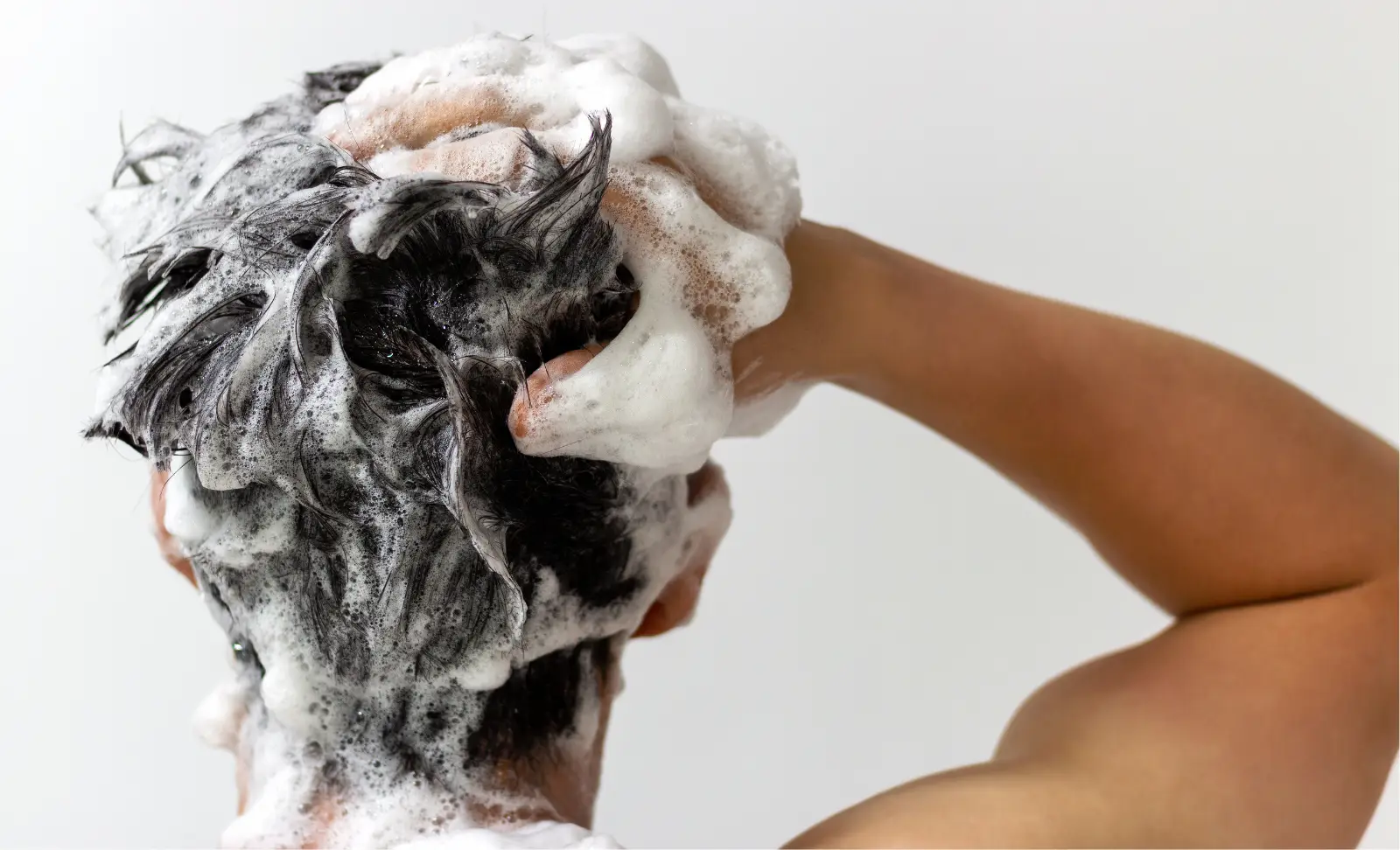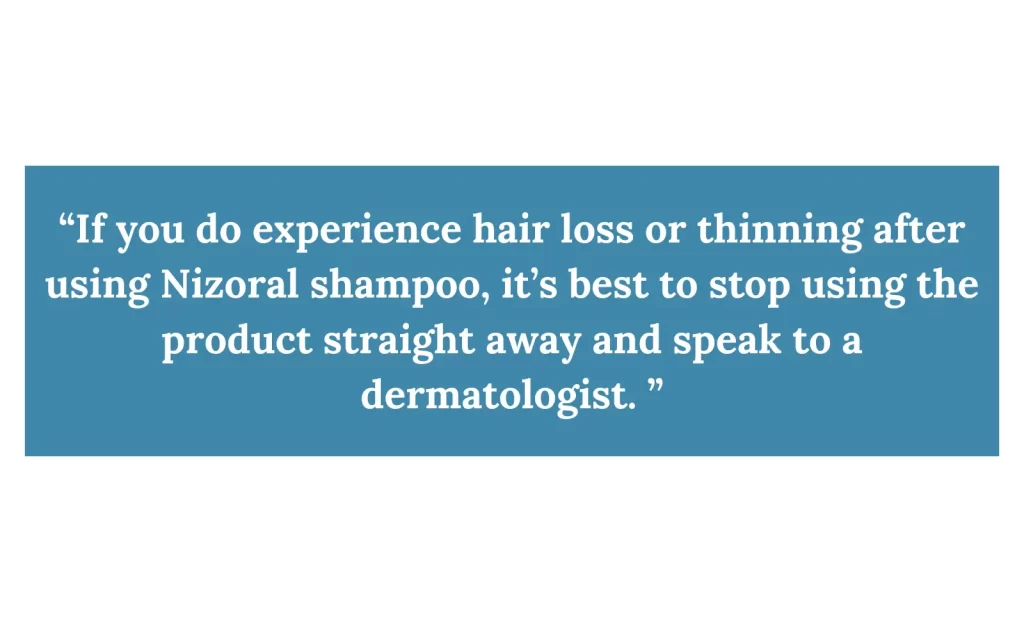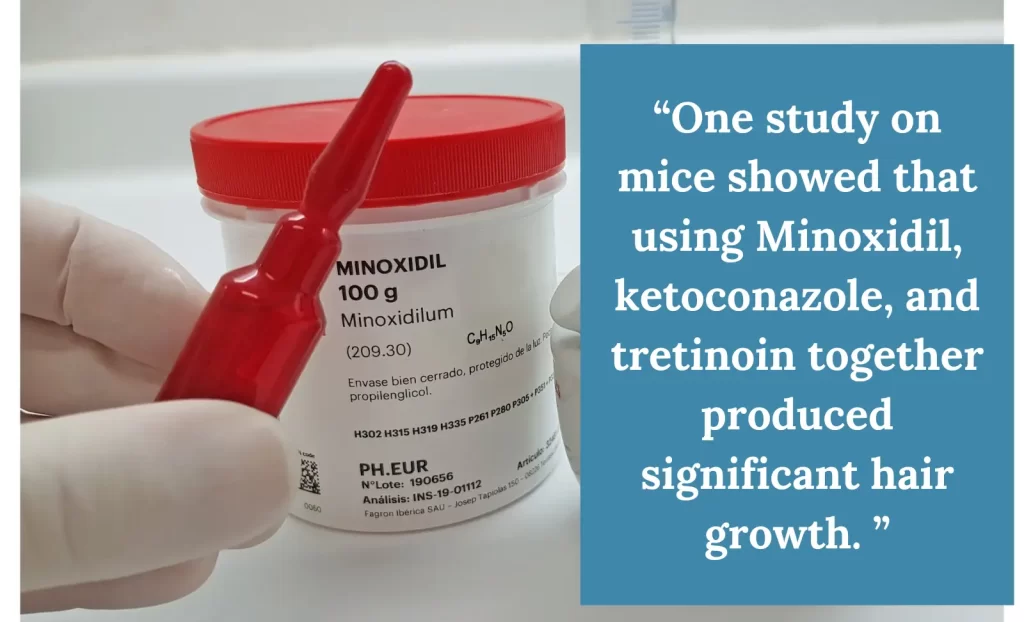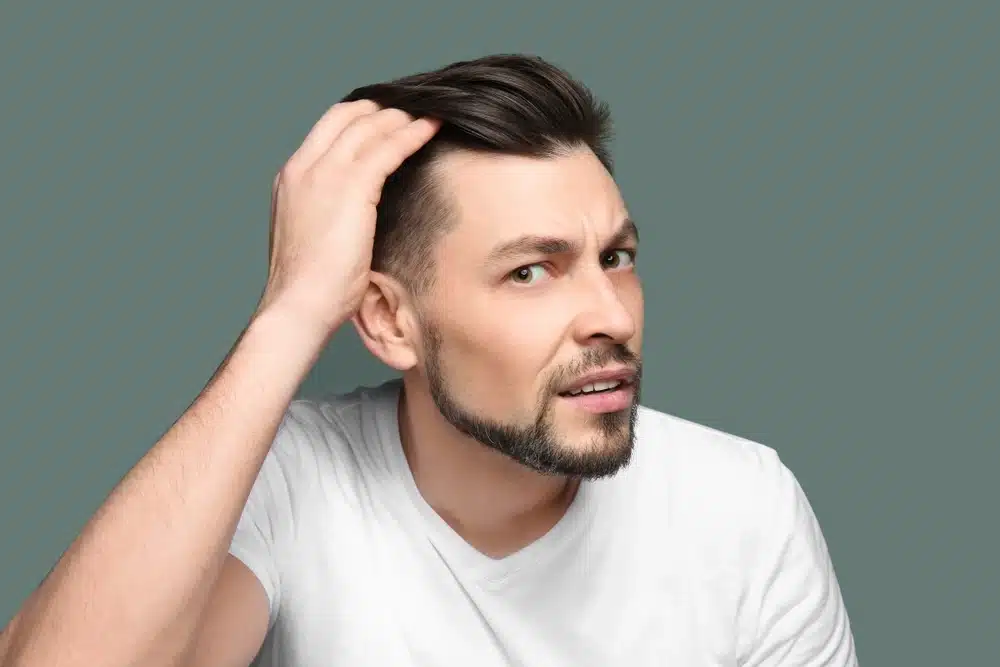
What is Nizoral Shampoo?
First, let’s understand exactly what Nizoral shampoo is. Nizoral shampoo contains the active ingredient ketoconazole, which is an antifungal medicine usually used to treat skin infections, including both yeast and fungal infections. [1] It works by treating and killing the fungi.
When in shampoo form as Nizoral shampoo, ketoconazole is usually used to treat scalp fungal infections and dandruff, with the product taking around 2-4 weeks to prevent dandruff. That’s not its only use, though – many people have also experienced positive results when using Nizoral shampoo for hair loss.
Does Nizoral Shampoo Work for Hair Loss?
Yes, Nizoral shampoo is actually a very popular topical method for treating hair loss. It works by preventing 5-alpha reductase from converting testosterone to DHT (Dihydrotestosterone). This male hormone is often responsible for enlarged prostates, excess body hair, and hair loss/thinning. When using Nizoral shampoo to prevent the production of DHT, it can help reverse the effect of hair loss.
Can Women Use Nizoral Shampoo for Hair Loss?
Yes. DHT-blockers have been shown as an effective method for reducing hair loss in women, as women may have too much DHT, which can cause hair loss (in the same way it can in men). As a result, Nizoral shampoo is a common hair loss treatment for both men and women.
Using Nizoral Shampoo for Hair Loss: 6 Steps
Ready to start using Nizoral shampoo to get your hair back to a healthy state? If you have the product ready, here are the steps you should follow.
Step 1: Wet Your Hair
First, you should wet your hair in the shower (or bath) as you would usually do before washing your hair.
Step 2: Apply a Small Amount to Your Scalp
Next, apply just a small amount to your scalp. A small amount in the palm of your hand should suffice.
Step 3: Lather
Once applied, begin lathering the Nizoral shampoo into the scalp, giving your head a small massage while you’re there.
Step 4: Leave for 3-5 Minutes
After that, leave the shampoo in your hair for between three and five minutes. You can use this opportunity to do other grooming tasks in the shower, such as washing your body or shaving your legs!
Step 5: Rinse Thoroughly
Finally, you can rinse the shampoo out. Do this thoroughly, and feel free to follow it up with your conditioner of choice.
Step 6: Notice the Results
Of course, like with any hair loss treatment (other than wigs and hair extensions), it will take a while for results to show, as you need to wait for the hair growth cycle. Hopefully, results will appear over time. Using a hair track app can help you monitor how much the Nizoral shampoo has boosted hair growth.
How Many Times Per Week Should You Use Nizoral Shampoo?
You don’t need to use Nizoral shampoo every day, and, in fact, you shouldn’t. It’s recommended that you use the product twice a week.
Are There Any Negative Side Effects to Using Nizoral Shampoo?
It’s important to first note that Nizoral shampoo is a widely used and dermatologically tested product that most people have no issues with. However, there are some side effects to be aware of before using it. If you experience any of the following, it’s best to stop further usage of Nizoral shampoo:
- An Itchy Scalp
- Dry Skin
- A Change to Hair Texture
- Headaches
- Rash
- Hair Loss
Some of these side effects are more common than others. For example, an itchy scalp is more likely than hair loss.
Nizoral Shampoo and Hair Loss
It might seem counter-productive to use a shampoo for hair loss when alopecia is one of the potential side effects, but remember that it is not a common occurrence, with hair loss for ketoconazole being listed under “rare” on Mayo Clinic. [2] If you do experience hair loss or thinning after using Nizoral shampoo, it’s best to stop using the product straight away and speak to a dermatologist. Usually, hair loss after using Nizoral is caused by telogen effluvium, which occurs after metabolic stress. [3]
Nizoral Shampoo Hair Loss: How Long Does it Take to Notice Results?
You can’t expect to see results straight away. Usually, if the Nizoral shampoo works for you, it will show after a matter of months. If you haven’t noticed any improvement after around three to four months, then the product may not work for you, and it’s probably worth looking at other hair restoration options.
Boosting Results with Other Products
If Nizoral shampoo doesn’t seem to work as effectively as you hoped, you may have better results when pairing the product with another hair-boosting ingredient, such as Minoxidil. One study on mice showed that using Minoxidil, ketoconazole, and tretinoin together produced significant hair growth. [4]
Alternative Hair Restoration Options
Nizoral shampoo isn’t the only way you can grow back your hair. If you’re struggling with hair loss, you’re likely ready to try various treatment options, especially if one is likely to work for you. There’s no better feeling than being able to naturally grow your own hair after experiencing hair loss, after all. Here are some other options that could help you.
Low-Level Laser Therapy
Low-level laser therapy uses a targeted low-level light to stimulate hair follicles, which, in turn, helps boost hair growth. It’s a minimally invasive and pain-free procedure offered by many clinics, with results showing through after around six months.
Minoxidil
A popular, topical treatment for hair loss is Minoxidil, which you can buy over the counter. It works by stimulating the hair follicles by boosting blood flow, leading to hair growth in many people, including both men and women.
Finasteride
Finasteride is a medicine like Minoxidil, but it’s usually taken orally. It works differently from Minoxidil, too, as it blocks the DHT hormone to help reverse male pattern baldness. You can only get Finasteride as a prescription, and it is only available to men (it’s not an effective treatment for women).
Alternative Shampoos
Nizoral shampoo isn’t the only shampoo to offer hair growth results. Other shampoos, such as caffeine shampoo, can also work well for growing your hair. Plenty of shampoos on the market claim to stimulate hair growth, and you might find that one works for you. However, it may end up a case of trial and error, and you may be better off choosing a treatment that’s directly made to treat hair loss with results backed up by science and clinical trials.
Hair Transplant
Hair transplants are good hair restoration options for those who have tried other solutions that haven’t worked. If topical treatments like Minoxidil or Nizoral shampoo have no effect on your hair – or the effect isn’t as good as you’d hoped – a hair transplant might make sense. There are two popular types of hair transplants, including the FUE hair transplant method and the FUT hair transplant method.
Is a Hair Transplant a Good Option?
Hair transplants are highly effective at treating hair loss, as they transplant healthy hair follicles into the problem area, which leads to natural hair growth. The FUE method is the one we recommend, as it produces the most natural results with the least amount of scarring. Of course, whether you’re a good candidate or not depends on your individual circumstances and your type of hair loss. A consultation is best to see if the procedure would work for you.
Nizoral Shampoo: A Hair Loss Treatment that Could Work for You
Nizoral shampoo can be effective for some people with hair loss but not so much for others. It’s minimally invasive with only a handful of potential side effects, making it a popular treatment option for many. Keep in mind, however, that the shampoo is mainly marketed for targeting dandruff rather than hair loss. If you speak to a GP or dermatologist, they will likely recommend that you go down another option, such as Minoxidil, as this has been proven to grow hair in clinical trials.
Get in Touch with the Harley Street Hair Clinic Team Today
Do you want to talk through hair restoration options? You don’t have to put up with losing your hair, not when there are solutions available. Here at Harley Street Hair Clinic, our team offers free, no-obligation consultations to discuss the FUE hair transplant process to see if it’s right for you. If other options like Nizoral shampoo aren’t working, this might be the best way to enjoy a full head of hair again. For an idea of what the results can offer you, take a peek at our patients gallery.
Sources:
- https://www.nhs.uk/medicines/ketoconazole/
- https://www.mayoclinic.org/drugs-supplements/ketoconazole-topical-route/side-effects/drg-20067739?p=1#:~:text=Tell%20your%20doctor%20if%20you%20have%20the%20following%20symptoms%20while,or%20redness%20of%20the%20skin.
- https://www.ncbi.nlm.nih.gov/books/NBK430848/#:~:text=Telogen%20effluvium%20is%20excessive%20shedding,and%2015%25%20are%20telogen%20hair.
- https://www.ncbi.nlm.nih.gov/pmc/articles/PMC3964684/




